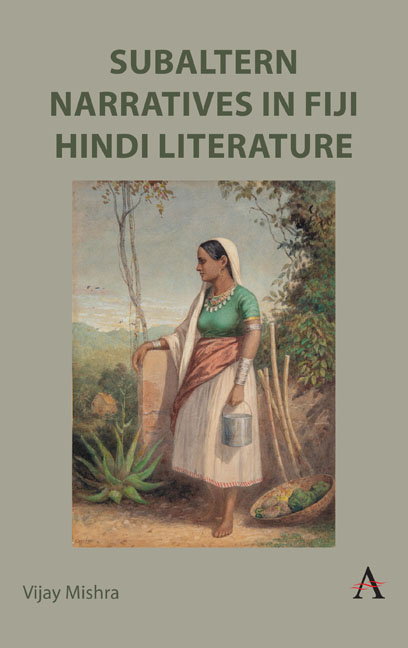Book contents
- Frontmatter
- Dedication
- Contents
- Acknowledgements
- A Note on Transliteration
- Map of Fiji
- Foreword: On the Genesis of Ḍaukā Purān
- Introduction: Reading the Fiji Hindi Demotic
- 1 Introduction: Reading the Fiji Hindi Demotic
- 2 The Moment of Ḍaukā Purān
- 3 Fījī Māṁ: The Female Subaltern Epic
- Conclusion: Can the Subaltern Speak? Language Itself Speaks
- Appendix: Glossary of Fiji Hindi and Fijian Words
- Select Bibliography
- Index
3 - Fījī Māṁ: The Female Subaltern Epic
Published online by Cambridge University Press: 13 April 2024
- Frontmatter
- Dedication
- Contents
- Acknowledgements
- A Note on Transliteration
- Map of Fiji
- Foreword: On the Genesis of Ḍaukā Purān
- Introduction: Reading the Fiji Hindi Demotic
- 1 Introduction: Reading the Fiji Hindi Demotic
- 2 The Moment of Ḍaukā Purān
- 3 Fījī Māṁ: The Female Subaltern Epic
- Conclusion: Can the Subaltern Speak? Language Itself Speaks
- Appendix: Glossary of Fiji Hindi and Fijian Words
- Select Bibliography
- Index
Summary
After Ḍaukā Purān, Subramani spent some 17 years writing an even larger subaltern novel, 1,000 pages long with a word count of over 300,000. If the first, narrated by a man, was a picaresque tale written in a comic mode (as indeed the conventions of the genre demanded), this novel, Fījī Māṁ (‘Mother of a Thousand’, hereafter without diacritical marks and given as Fiji Maa), narrated by a woman, is the ‘subaltern historical novel’, a national allegory, with an epic sweep of a thousand [and one] tales. The novel, clearly structured as a filmic narrative, deploys cinematic techniques of representation with the point of view of the eye of a camera. Indeed, cinema is what the novel becomes in the end as we are informed that fiction – here narrative as biography – will exist in the cultural domain as film and not as book. There is, however, a more difficult reading which is embedded in the novel itself, and this reading turns the reader's attention to language. As a literary work of art, this subaltern work too exists as language, a demotic language that captures the cri en cale, the scream from the hold. This cry or scream that produced the Fiji Hindi demotic is the voice of the coolie, part of the girmitiya historical consciousness through which experience is given form. In other words, discourse itself speaks, as language carries the experience of the race: language, in short, functions as ideology. Language makes the novel a private subaltern affair as it registers a mode of literary articulation that, like an anti-language, is an exclusive social semiotic of the people, a people who can only speak to themselves. It follows that any reading of the text is an exercise at once of interpretation (hermeneutics) and annotation (poetics).
Fiji Maa is divided into six parts of variable length: Kū Kū Esṭeiṭ (167 pages), Matuvālā Gāoṁ (443 pages), Beivākābulāī (97 pages), Beimānā (217 pages), Kū Kū Esṭeiṭ (51 pages) and Matuvālā Gāoṁ (50 pages). If importance is to be gauged by the length of the parts, then the second part, as the longest (around 40 per cent of the novel), is the centre of the novel.
- Type
- Chapter
- Information
- Subaltern Narratives in Fiji Hindi Literature , pp. 109 - 168Publisher: Anthem PressPrint publication year: 2024

